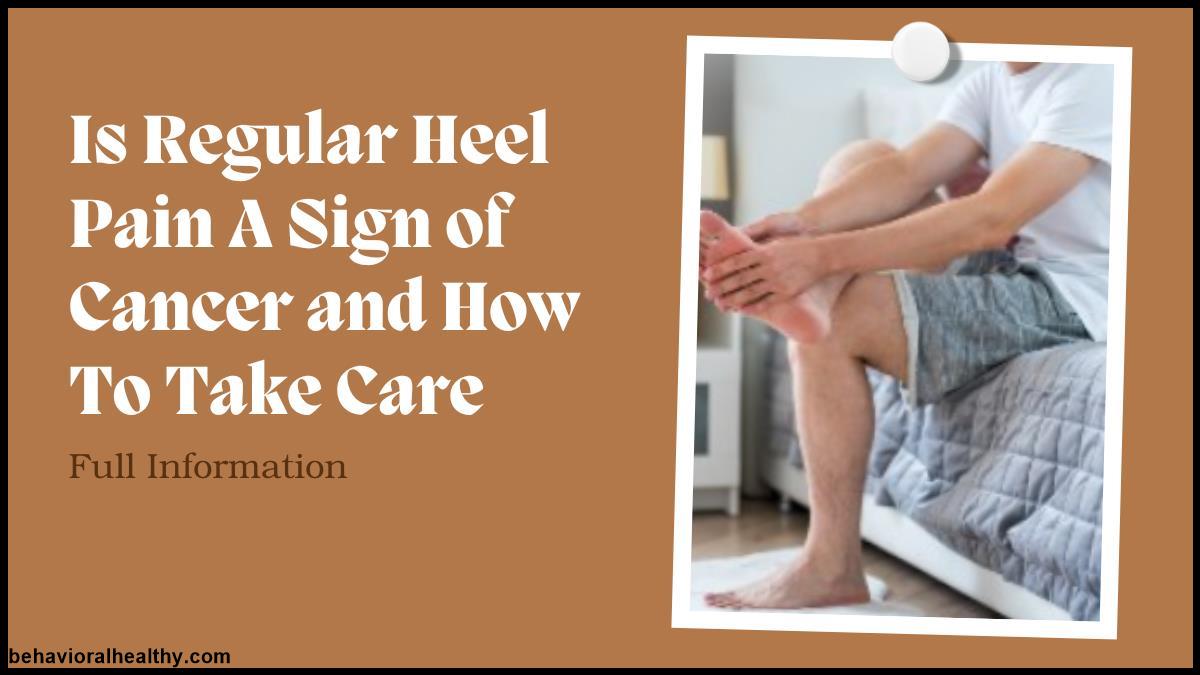The question - Is Heel Pain a Sign of Cancer? Generally, heel pain is not due to cancer, but some changes should not be overlooked.
Table of Contents
How Can You Differentiate Between Normal Heel Pain and Cancer Symptoms?
Heel pain is a common problem that many people face for a variety of reasons, including standing for long periods, vigorous exercise, and improper footwear. However, some people don’t let go and whisper the question - is heel pain a sign of cancer? Generally, heel pain is not due to cancer, but some changes should not be overlooked. Differentiating between normal heel pain and symptoms associated with cancer is important for early diagnosis and successful treatment.
Common Causes of Heel Pain
Before discussing the relationship between heel pain and cancer, it is important to know the usual non-cancerous causes of heel pain. These include:
- Plantar Fasciitis: Inflammation of the plantar fascia, a thick band of tissue that runs across the bottom of the foot and connects the heel bone to the toes, is the most common cause of heel pain.
- Achilles Tendinitis: Overusing the Achilles tendon may cause inflammation and pain in the back heel.
- Heel Spurs: Sharp pain, particularly in the morning, can be an indicator of calcium deposits buildup under the heel bone.
- Stress Fractures: Small cracks that occur in the heel bone due to continuous stress or high-impact activities cause discomfort.
- Bursitis: Inflammation of the fluid-filled sacs (bursae) near the heel joint can cause pain and swelling.
- Tarsal Tunnel Syndrome: Irritation of the tibial nerve due to compression at the ankle can result in burning pain, tingling, or numbness in the heel and foot.
These types of conditions are treated with rest, physical therapy, and medication. But if treatment for heel pain does not bring relief, a medical evaluation is required.
When Is Heel Pain a Sign of Cancer?
The question is, is heel pain a sign of cancer? It is not completely unfounded. However, some malignancies, though rare, can come with continuous heel pain. These include:
Bone Cancer (osteosarcoma or Ewing sarcoma)
Heel pain that doesn’t improve with rest gets worse and comes with swelling or lumps could be a sign of bone cancer. Osteosarcoma and Ewing sarcoma have diverse age distributions, with incidence highest in younger individuals, but with these tumors also occurring in people of all ages. These gains present chronic pain and discomfort in the area.
Soft Tissue Sarcomas
Sarcomas are cancerous tumors that develop in connective tissues like muscles, fat, and nerves. In the foot or heel, soft tissue sarcomas can cause pain, swelling, or lumps.
Metastatic Cancer
In rare cases, cancers start in another part of the body, such as the lungs, breast, or prostate. It can metastasize to the bones, including the heel. Those with a past of cancer who develop unusual pain in the heel area must be checked by a doctor.
Leukemia and Lymphoma
Certain types of leukemia, a blood cancer, can cause bone pain, particularly in the heel. This pain is usually deep and constant, unlike the tenderness of common heel disorders.
Differences Between Normal Heel Pain vs. Cancer-Related Heel Pain
Feature | Normal Heel Pain | Cancer-Related Heel Pain |
Pain Onset | Gradual, linked to activity | Persistent, worsens over time |
Pain Pattern | Improves with rest & therapy | Worsens at night, doesn’t improve |
Swelling/Lump | Rare, unless injured | Often present, may grow in size |
Response to Medication | Improves with pain relievers | Little to no improvement |
Other Symptoms | Usually, just heel pain | Weight loss, fatigue, fever, night sweats |
Consult a healthcare professional immediately if your heel pain does not respond to usual treatments, is worsening, or is associated with other symptoms.
Conditions That Can Make You Feel Like You Have Cancer
Some illnesses can feel like the symptoms of cancer, causing users to overreact. These include:
- Severe Plantar Fasciitis: More debilitating cases can induce extreme pain and swelling, and it feels like a tumor.
- Infections: When the bone becomes infected, a condition known as osteomyelitis, the heel region may become intensely painful, red, and swollen.
- Autoimmune Diseases: Chronic heel pain can be caused by conditions such as rheumatoid arthritis and lupus.
Management and Treatment
If cancer is found, treatment depends on the type and stage of cancer and may include:
- Surgical: To excise the tumor if possible.
- Radiation therapy: For tumor reduction and pain relief.
- Chemotherapy: Used to target cancer cells in more advanced cases.
- Symptom Management: Including medications and therapies to alleviate symptoms.
If the pain is due to a benign cause, treatments such as physiotherapy, orthotic inserts, anti-inflammatory medication, and lifestyle changes can be highly effective.
End Note
Heel pain is a common complaint, most commonly from common musculoskeletal problems. However, though rare, it could signal an underlying malignancy. If you’ve ever thought to yourself, Is heel pain a sign of cancer? The answer is that while heel pain is rare to be cancer, any persistent, worsening, or unusual heel pain should never be ignored.
If it is detected early, it can be treated to get better outcomes. If your pain isn’t improved with standard treatments (rest, ice, heat, pain medications) or if you have systemic symptoms (like fever, redness, swelling, or warmth to the touch), contact your physician immediately. Differentiating between normal heel pain and cancer symptoms can help you make informed health decisions.

